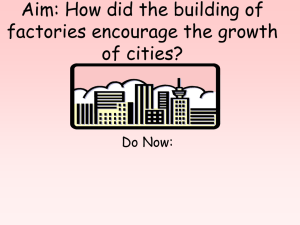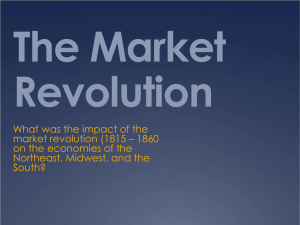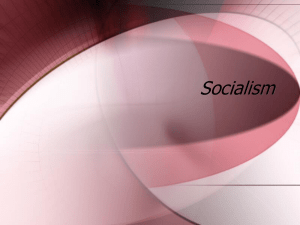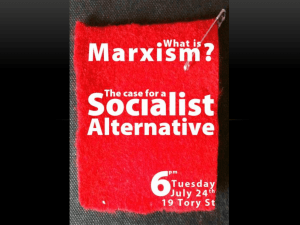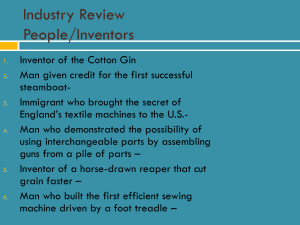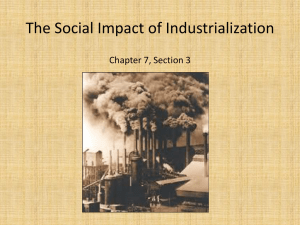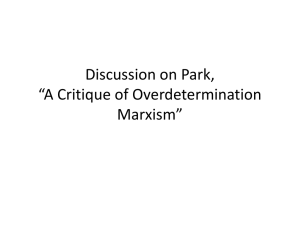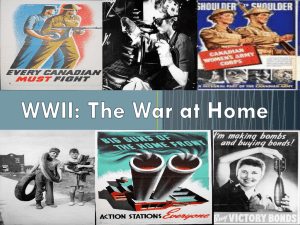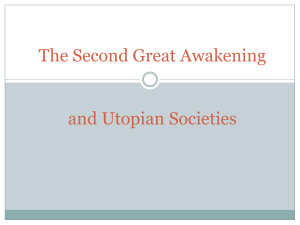AP21 Economic Advance & Social Unrest21
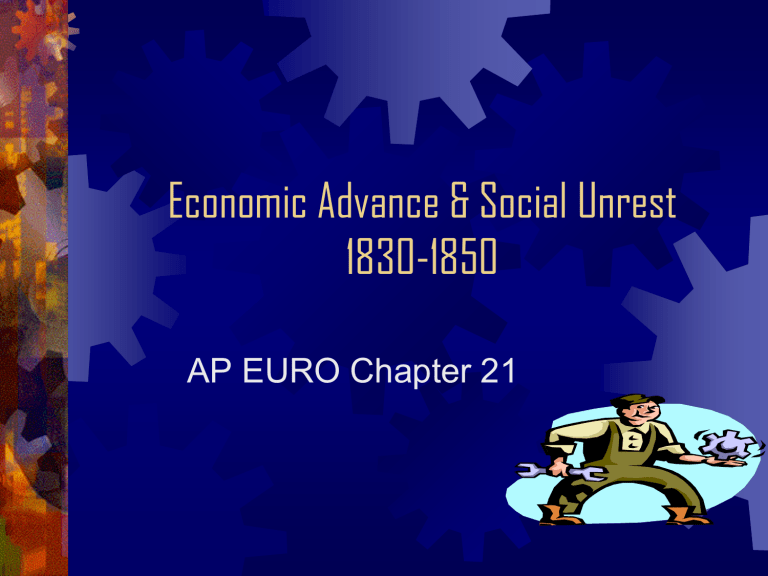
Economic Advance & Social Unrest
1830-1850
AP EURO Chapter 21
Shift From Human and Animal
Power to Mechanical Power
1. Agricultural Revolution 1700’s led to abundant food supply
2. the Enclosure Movement forced many poor rural people to move to cities and work in factories
http://www.youtube.com/watch?v=d4joq
YycnqM
Population Growth
Europe’s population increased from
120 million in 1700 to
190 million in 1800
This growth in population created a pool of workers
Why Did the Industrial
Revolution Begin in England ?
1. Innovations in agriculture (mid
1700’s)
2. New Technology -Textile industry
3. Large population
4. Stable Economy
5. Coal & Iron Production
6. Harbors & Rivers
British Textile Industry
Introduction of the
Factory system led to growth of Textile
Industry
Textiles shipped all over the world
Great Britain ’ s economic foundation
British Textile Industry
Manchester, England
Center of Textile
Industry
Population grew due to:
Urbanization – movement of people to cities
Manchester, England
In 1842 a German visitor noted that he had seen so many people in the streets of Manchester without arms and legs that it was like "living in the midst of the army just returned from a campaign."
Working Conditions in
Factories 1750-1800’s
Dangerous machinery
Loss of limbs, life common
No ventilation, sanitation
hot / cold
No such thing as worker ’ s rights
CHILD LABOR
Western European Countries
Followed Industrial Pattern by 1830 People Migrated to cities:
1. In England: ½ of population moved to cities
2. France: ¼ moved to cities
Impact of Migration …
Cities not Prepared to receive Large
Numbers
1. Inadequate housing
2. Contaminated water, sewers
3. Disease
4. Crime
5. Degradation at factories
Railways Facilitated
Movement
1830 ’ s-1840 ’ s
Construction of:
1. Railroad building
2. Canals,
3. Roads
Cheaper, faster
Methods of transportation for people and products
Factories & Wage Labor
End of the domestic system
Displaced previous skilled laborers
Factory workers contributed their labor for a wage
Proletariat – industrial workers who sell their labor to live.
Factory Owners Preferred …
Hiring young, single women or widows to work in factories
in some cases
Children instead than the wives were sent to work
Changes in Family Structure
Family ceased to be the basic unit of production and consumption
Economic & home life no longer the same
Laboring Poor
Long hours, low wages, unskilled workers
Women received lower wages
Factories and mines employed children as young as 6
Irish Potato Famine 1845-
1847
Potatoes introduced from South America in 17 th cent.
Irish peasants depended on potato crop
Irish Potato Famine 1845-
1847
1845 a fungus
(blight) Harmed crops
½ million Irish peasants died
Survivors immigrated the
United States
Irish Potato Famine 1845-
1847
English Factory Act, 1833
Forbade employment of children under 9
Limited the workday for children (9-13) to
9 hours
Mines Act, 1842
Women and children under 10
Forbidden from working in mines
Ten Hours Act, 1847
Limited the workday for women and children
To 10 hours per day
Chartism
1 st large scale European working class movement
Workers sought political reform
Petitions with signatures
London Workingmen ’ s Association demanded 6 specific reforms
Chartism – charter 6 reforms
1. Universal male suffrage
2. Annual election of House of Commons
3. Equal electoral districts
4. Abolition of property qualifications for members of House of Commons
5. Secret ballot
6. No payment of salary to House of
Commons
Response Urban Crime
Professional Police Force are established
1. Paris 1828
2. London 1828 (Bobbies)
Visible presence deterred crime
Prison Reform
Late 18 th Century – Mid 19 th Century: serious offenders sentenced to transportation to Australia!
Prison Reform
1840 ’ s France & England led the way
Goal of prison = to rehabilitate prisoner
Individual cells, separation form other prisoners led to self- reflection
Classical Economists
Studied the problems created by industrial communities
“ grim economists ”
1. Thomas Malthus
Essay on Principle of Population (1798)
Population will always be greater than food supply
Poverty and misery will always exist
2. David Ricardo
Principles of Political
Economy (1817 )
“ Iron Law of Wages ”
If wages are raised, parents have more children.
More laborers = lower wages, fewer jobs
Early Socialism …
1. response to industrial revolution
2. disapproves of current economic systems
3. Questions private ownership & means of production
4. fairer distribution of income among working class
Utopian Socialism
1. Saint-Simon - France
-planned society public owns capital & industrial equipment
-no need for nobility or clergy class
-laborers = productive citizens
Utopian Socialists
2. Charles Fourier – France
Imagined utopian communities
“ phalanxes ”
Made up of 1,620 individuals
Never materialized
Utopian Socialists
3. Flora Tristan
Fought for equality for women in marriage & workplace
Utopian Socialists
4. Etienne Cabet – French
Wrote novel describing ideal city w/ economic harmony & education
5. Louis Blanc“ national workshops ” state supported manufacturing centers for unemployed
G.W.F. Hegel ’ s Theories
1. Reality a process of endless change
2. History results from a series of change or
3. “ Dialectic ” reaction of opposites
G.W.F. Hegel ’ s Theories
A given state of affairs is called
“ thesis ”
It produces the concept of an opposite state, “ anti-thesis ”
Any reconciliation of the two “ synthesis ”
As ideas clash, new ideas emerge
Marxian Socialism
Karl Marx & Friedrich Engels
Both Write : Communist Manifesto ,
1848
Marx Wrote : Das Kapital , 1867
Engels Writes: The Condition of the
Working Class in England, 1844
Influenced by Hegel
Marxian Socialism
1.History advances through conflict
2.Economics major force of change
3.Class that controls production becomes ruling class
4. Conflict between classes is inevitable
Class struggle moves history forward.
Marx ’ s 4 Stages of Economic
Life
1. Primitive
2. Slave
3. Feudal
4. Capitalist
Therefore …
Socialism – means of production, such as capital, land, raw materials, factories or land should be owned and controlled by society
Communism – In the theories of Marx &
Engels, a society without class distinctions or private property
The Age of “ -isms ”
1815-1830
The age of ideologies, or “ -isms ”
“ -isms ” influence how people viewed events and motivated them to action
Revolutions 1848
Revolutions All Over Europe
1848
Causes:
1. Liberals feel frustration at lack of political change
2. Ethnic minorities left out
3. Lives of working class
Revolutions of 1848
General Desires:
1. Constitutions
2. Independence & unification of nationalist groups
3. End of serfdom in Eastern Europe
